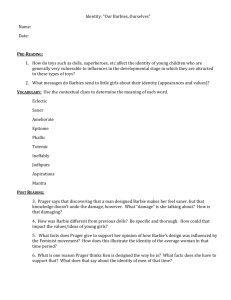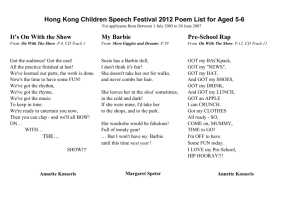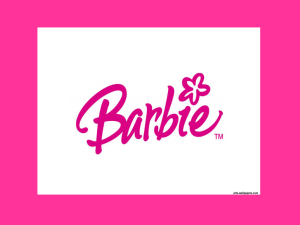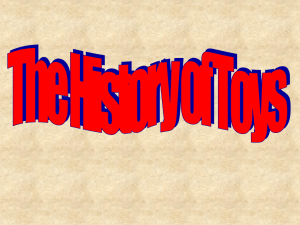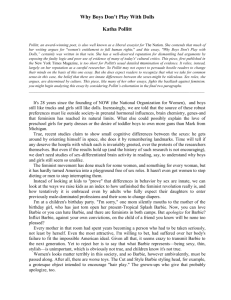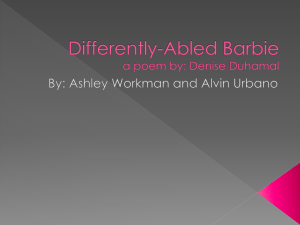Arguementative Essay Final
advertisement
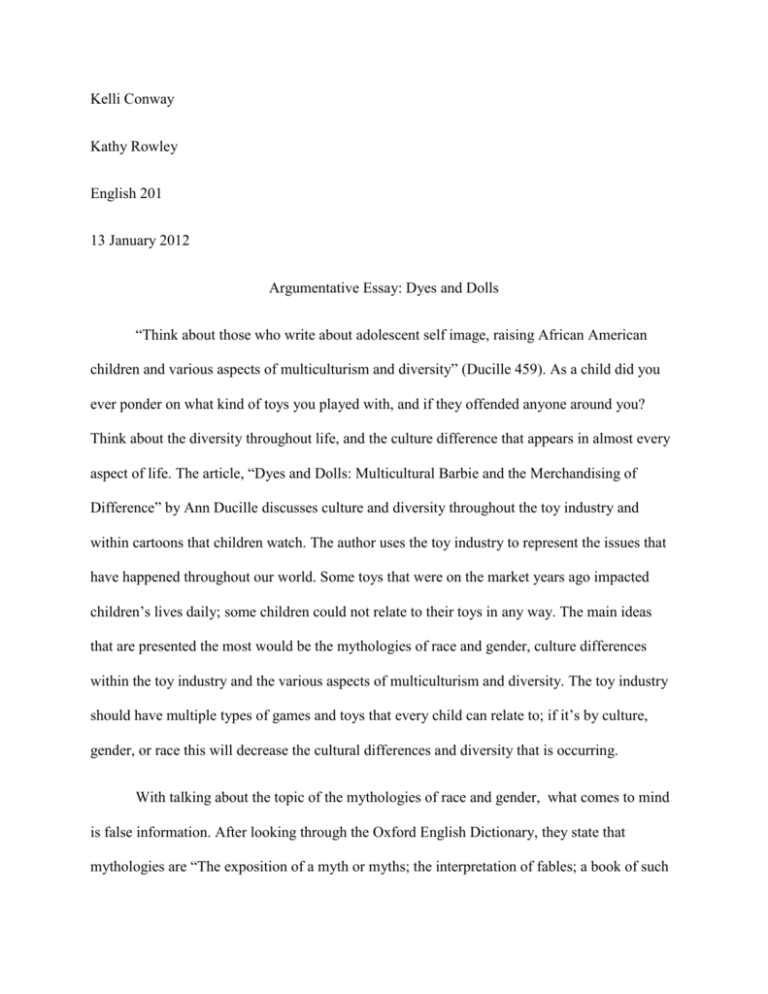
Kelli Conway Kathy Rowley English 201 13 January 2012 Argumentative Essay: Dyes and Dolls “Think about those who write about adolescent self image, raising African American children and various aspects of multiculturism and diversity” (Ducille 459). As a child did you ever ponder on what kind of toys you played with, and if they offended anyone around you? Think about the diversity throughout life, and the culture difference that appears in almost every aspect of life. The article, “Dyes and Dolls: Multicultural Barbie and the Merchandising of Difference” by Ann Ducille discusses culture and diversity throughout the toy industry and within cartoons that children watch. The author uses the toy industry to represent the issues that have happened throughout our world. Some toys that were on the market years ago impacted children’s lives daily; some children could not relate to their toys in any way. The main ideas that are presented the most would be the mythologies of race and gender, culture differences within the toy industry and the various aspects of multiculturism and diversity. The toy industry should have multiple types of games and toys that every child can relate to; if it’s by culture, gender, or race this will decrease the cultural differences and diversity that is occurring. With talking about the topic of the mythologies of race and gender, what comes to mind is false information. After looking through the Oxford English Dictionary, they state that mythologies are “The exposition of a myth or myths; the interpretation of fables; a book of such expositions”. (Oxford) After analyzing this, throughout our world there are many myths to the gender and racial image. In our world there are many people that act as if they are a different race to just fit it, or act as if they are the opposite gender to fit in. Everyone should be their own person and not have to try and be someone else. Having so many cultures in our world today is such an amazing aspect of life. As for children growing up, they should always live carefree lives and not be worrying about things like gender and culture differences. “The adults who surrounded me were all white as were the teachers who taught me, and the neighborhood children who called me nigger one moment and friend the next. And when my brothers and I went our separate ways into properly gendered spheres the dolls I played with like almost everything else in my environment were also white” (Ducille). After expressing how she is feeling, Ducille explains how all of these things that are revolving around her are so different from what she is like. Nothing or no one resembles her own self image. She questions, if being African American is even okay in our society. As a young child, she should not be thinking on this note. Just because her skin color is different from others, shouldn’t mean that she is categorized different from others. Because this was happening to Ducille, she was feeling disconnected from her own culture. Children and adults in our world should not be calling someone of the opposite race names like Ducille was being called. This falls somewhat in the lines of the mythologies that occur within race to categorize people just because they are African American or a person of color. On another note, people seem to have unrealistic thoughts about race and gender in our world especially when it comes to the toy culture. In Ducille’s article, she states, “Barbie’s body type constructs the bodies of other women as deviant and perpetuates an impossible standard of beauty” (Ducille). Thinking about the image that is portrayed within the innocent cartoons and Barbie dolls presented to children all have the common myths of race and gender encoded in them. Barbie’s body type; blonde, blue eyed, big breast, and curvy plastic bodies are all a whole myth. That is not what a typical woman in our world today looks like. This is portrayed as an unrealistic image on our society, which concludes to the idea of the mythologies that occur through race and gender. In the whole article, “Dyes and Dolls” it discusses all about culture differences revolving in the toy industry. Toys and games play a crucial role in helping children determine what is valuable in and around them. Almost every young girl loves playing with Barbie’s or some kind of doll. “Barbie allows little girls to dream” (Ducille). With all of the accessories, huge houses, and beautiful cars that you can buy they really allow girls to dream in that aspect. When Barbie dolls first came out they only released the white, blonde, blue eyed doll. For the African American children or the children with color this was a struggle. There is not only one type of person in our world. The different cultures and racial backgrounds that people have is a beautiful thing about life; it shouldn’t make some feel disconnected from their own culture. From the article, “Ethnically Correct Dolls: Toying with the Race Industry” by Elizabeth Chin, she states, “Embodied in these children’s activities is a profound recognition that race is not only socially constructed but has the potential to be imaginatively reconstructed”. She continues to go on… “The problems that have been posed for the assertions of the ethnically correct toy makers who argue that children of color play better with dolls that “look like them”” (Chin). In this article, a case study has been done on children to see what toys they choose to play with. Chin noticed that with the toys, the racial factor was a huge impact on the children. After reviewing this source, children seem to reflect off of the image to the extreme of their toys that are given to them. For children of color, before the 60s, they only had Caucasian dolls to play with. But closer to the 70s, they came out with black dolls that resembled a lot more of the children. Looking at the problems by consumers of the culture differences it puts a huge affect on the toy industry. Today they have a ton of multicultural dolls; like the Jamaican Barbie, Nigerian and Kenyan Barbie, Malaysian Barbie, Chinese Barbie, Mexican, Spanish, and Brazilian Barbie. If they would have came out with all of the different cultured Barbie’s when they came out with the first one then there would have been a lot less struggle and stress put on children that consumed those toys. After decades our society goes through transitions and changes throughout education, families, and life in general. The article “Schools and the Diversity Transition in the Wealthy Societies of the West by Richard Alba states, “The transition means that these societies will depend increasingly on individuals who have grown up in immigrant homes to maintain economic, social, and cultural vitality” (Alba). He discusses immigrant children growing up in schools and the transitions that they go through with the education systems. There were many examples of how schools do things differently. Also Alba discussed how societies are going to depend on the older generations to step in, maintaining the cultures and diversity. Our society influences and contributes incredibly to the making of culture through the way we produce and consume things in life. For instance, at school children always seem to want to have the new and best toy, when the older version has the same purpose. Economically, this is not realistic and adults need to teach their children that always having the new “better” toy is not reasonable. Involving the children in education systems, even though the schools might go through diverse transitions, the fact that some immigrant families put their children through school is an amazing opportunity for them. Throughout culture there are many different aspects that can be looked at as well as in multiculturism and diversity. When thinking of diversity within cultures it doesn’t necessarily always appear to be negative. Diversity can be a good thing today. In the article, “Dyes and Dolls”, Ann Ducille discusses multiculturism in a couple different ways. Ducille states, “Some of the most blatant and simplistic representations of white as good and black as evil are found in children’s literature. Where black witches and good white fairies- heroes in white and villains in black- abound” (Ducille). She explains in this part of her article how there is an extreme amount of diversity throughout children’s cartoons, children’s toys, and even in the seemingly innocent fairy tales. For instance, with some children’s stories there always is an evil witch and a nice witch. As an example, in the story of Wizard of Oz the bad witch is portrayed all in black and her sister the good witch is portrayed in the soft white colors. That shows the diversity our society puts between people. All of those three types of examples that are presented to children have the same aspect of diversity within them. The article, “Commodity Cultures” by Peter Jackson argues more on the complexity of people’s relationships in the world within the culture aspect. There were a lot of diverse responses from this research. The whole thing is focusing on what is happening today in our world with commodification of forms of culture difference, and what can be changed in future research. He explains, “the problem that has been occurring is that there has been a tendency to equate culture with consumption” (Jackson). This relates to what Ducille brought up with cartoons and everything that children consume. All of these toys and shows that children watch have an underlying message of culture difference and diversity within them. If that is all they are consuming then there will be an increase of multiculturism and difference in their lives which is not what children at a young age need to be thinking about. “I grew up believing that I was ugly: my kinky hair, my big hips, and the gap between my teeth” (Ducille). In “Dyes and Dolls”, Ducille talks about how different she felt from others. This resulted from her playing with dolls that didn’t resemble her, and being around people that physically looked different from her. As a child, all she is going to see is the physical appearance, and notice that she does not resemble anything that she is interacting with. Ducille could have been socially impacted by this as well because of the loneliness she was feeling. If a child feels disconnected from everything in their environment, they will be impacted from the social aspect as well. Children should be happy little spirits, and not always put down by the environment they are in. “Mattel reaches halfway around the world and gives little girls- black like me- Nigerian Barbie’s to play with” (Ducille). Thinking from this, it seems that they are improving the sense of difference and diversity. Trying to advertise a Barbie that is of another racial background then the typical Caucasian Barbie, is an improvement. She goes on and explains how even though Mattel brought the “Nigerian Barbie” out, they still sell it like the traditional blue eyed, blonde. These Barbie dolls have no imperfections to them. Growing up, especially girls need to realize that there are imperfections in life. Putting on a front about how everyone is perfect in life is wrong. The company, Mattel is giving little girls a dream, and not what actual life is all about in the physical aspect. In the article, “Global Encounters: 'Barbie' in Nigerian Agbogho-Mmuo Mask Context” by Chinyere Okafor they discuss the Barbie doll image that represents the beauty image throughout our world. In America people look at this image and want to be identical to it. But beyond that, this article discusses how and who it affects globally. They specify Nigeria, and how the unrealistic image of Barbie affects women and their health. The article goes further and discusses the multiple types of images represented by Barbie dolls. “In Nigeria, we appreciate this so that the flaws with her can be acknowledged” (Okafor). Nigerians shouldn’t need to look at a Barbie doll to feel accepted, while also struggling with their own health just to be portrayed like someone else. This image that is portrayed is a physiological impact on women as well. This is a perfect reflection of what the unrealistic image does to innocent people in our world today and shows the culture differences and diversity through something that is a piece of plastic named Barbie. People need to be themselves and not worry about others. In the article, “Ethnically Correct Dolls” by Chin, from the case study two girls were asked to talk about Barbie, and tell about her. They reply, “You never see a fat Barbie. You never see a pregnant Barbie. What about those things? They should make a Barbie that can have a baby” (Chin). When young girls like this realize these things, it is definitely alarming. But it is true, there is not one “fat Barbie” that is being advertised, as well as a pregnant one. The young girls can immediately see the multiculturism and the difference through the dolls that they are playing with. Why doesn’t the company Mattel create a Barbie doll that resembles every single type of person in our world today? Our world has become so incredibly separated with culture differences, race and gender. “Have we progressed to a point where “difference” makes no difference? Or have we regressed to such a degree that “difference” is only conceivable as similarity” (Ducille). Having all of these different aspects and responses to the diversity, the culture differences and the myths towards race and gender in our world is shocking. Ducille has made an outstanding argument towards it all as well as the other authors that have been presented throughout this essay. There needs to be some change within the toy industry. It doesn’t have to be huge, but just within our toys, cartoons, and even fairy tales. Since back when Ducille was a child, our society has made some changes with the multicultural Barbie’s, and having the different racial dolls you can buy. Within daycares, schools and homes toy manufactures need to listen to the consumers demand for toys that portray how diverse and multicultural our world is. There could still be some change that would bring our world even more together, and not segregated into categories of race, gender, and culture. Children should not be consuming these issues that are presented in the cartoons they watch in the morning, or the fairy tales they read before going to bed. “Is Barbie bad? Barbie is just a piece of plastic, but what she says about the economic base of our society- what she suggests about gender and race in our world- ain’t good” (Ducille). Works Cited Alba, Richard. "Schools And The Diversity Transition In The Wealthy Societies Of The West." American Behavioral Scientist 55.12 (2011): 1616-1634. Academic Search Complete. Web. 23 Jan. 2012. Chin, Elizabeth. "Ethnically Correct Dolls: Toying with the Race Industry." American Anthropologist 101.2 (1999): 305-21. JSTOR. Web. 23 Jan. 2012. <http://www.jstor.org.ezproxy.library.ewu.edu/stable/683203>. Greene, Stuart. "Dyes and Dolls: Multicultural Barbie and the Merchandising of Difference." From Inquiry to Academic Writing. Boston: Bedford/St. Martin's, 2008. 458-77. Print. Jackson, Peter. "Commodity Cultures: The Traffic in Things." Transactions of the Institute of British Geographers 24.1 (1999): 95-108. JSTOR. Web. 23 Jan. 2012. <http://www.jstor.org.ezproxy.library.ewu.edu/stable/623343>. "Mythology, n.". OED Online. December 2011. Oxford University Press. 7 March 2012 <http://www.oed.com/view/Entry/124702?redirectedFrom=mythology>. Okafor, Chinyere G. "Global Encounters: 'Barbie' in Nigerian Agbogho-Mmuo Mask Context." Journal of African Cultural Studies 19.1 (2007): 37-54. JSTOR. Web. 23 Jan. 2012. <http://www.jstor.org.ezproxy.library.ewu.edu/stable/25473377>.
